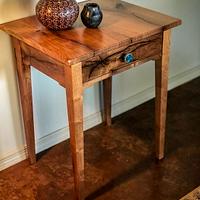Share your craft projects
Make new craft buddies
Ask craft questions
Blog your craft journey

shipwright
2135 posts
and
113 followers
in over 11 years
in over 11 years
Watercolour Dye Technique #7: Flip, Flop, and Press ... protecting the dye
This is
part 7
in a
7 part
series:
Watercolour Dye Technique
.
Warning: boring content. ............ This is technical junk about a sequence of events that will interest people who want to try this technique. Others may fall asleep.
The marquetry and dyeing are done so the next step is to mount the assembly on a substrate, right?
Not so much. First and foremost the very fragile surface dye must be sealed to prevent its being abraded or smeared in the mounting process. To make things just a little trickier the Contact paper that it is currently mounted on is not sticky enough to keep all the bigger pieces flat without weights to help and you can't have weights on top when you're sealing it.
So the next step was to tape over the face side with medium tack tape, strong enough to hold the pieces briefly but not so strong as to pull dyed fibers off the surface.
Warning: boring content. ............ This is technical junk about a sequence of events that will interest people who want to try this technique. Others may fall asleep.
The marquetry and dyeing are done so the next step is to mount the assembly on a substrate, right?
Not so much. First and foremost the very fragile surface dye must be sealed to prevent its being abraded or smeared in the mounting process. To make things just a little trickier the Contact paper that it is currently mounted on is not sticky enough to keep all the bigger pieces flat without weights to help and you can't have weights on top when you're sealing it.
So the next step was to tape over the face side with medium tack tape, strong enough to hold the pieces briefly but not so strong as to pull dyed fibers off the surface.

All taped and turned over, the Contact paper peals very easily, hardly pulling any little pieces up with it … but a few of course. Now I can replace it with the same medium tack tape and remove the front tape. Flip ...... flop …
When the front tape is off I can press the assembly to improve the tack of this back side tape.
Aside: Here's the thing, from an artistic point of view both my wife and I really liked the incidental dye job on the back (one of us liked it better than the front … 'nuf said)


With the pieces now securely mounted on the back side it is safe to spray a coat or two of oil based poly on the dyed surface to protect it from moisture.

And flipping one more time, the front is laid on another sheet of Contact (low tack) paper and the back tape is removed. this is a little tricky as the tape is much better stuck than the Contact, but eventually I got all the little fence posts and grape vine bits stuck back where they belonged and I could proceed to pressing onto the final substrate.


Once out of the press I coated the whole piece with a good protective (and leveling) coat of epoxy.
(Shiny isn't it?)

From here on it's just a matter of sanding the epoxy flat and finishing with a couple of coats of spray
semi-gloss poly and cutting the edges to final shape.
There may be an easier way to do this but I thought the processes through and am happy that I came up with a sequence that worked. It may seem like a lot of steps but each one has a good reason behind it.
That's it. Ill post the project shortly
Thanks for looking in.
Paul
The early bird gets the worm but its the second mouse that gets the cheese.
2 Comments
Mind blown. That’s so amazing.
Half of what we read or hear about finishing is right. We just don’t know which half! — Bob Flexner
What a process, and artistic on so many levels. Thank you for sharing.
Do you have any issues with the grain lifting while using the dyes? Like when I use stains sometimes, I get those small fuzzies which need to be lightly sanded before the clear coat.
Do you have any issues with the grain lifting while using the dyes? Like when I use stains sometimes, I get those small fuzzies which need to be lightly sanded before the clear coat.
Main Street to the Mountains










